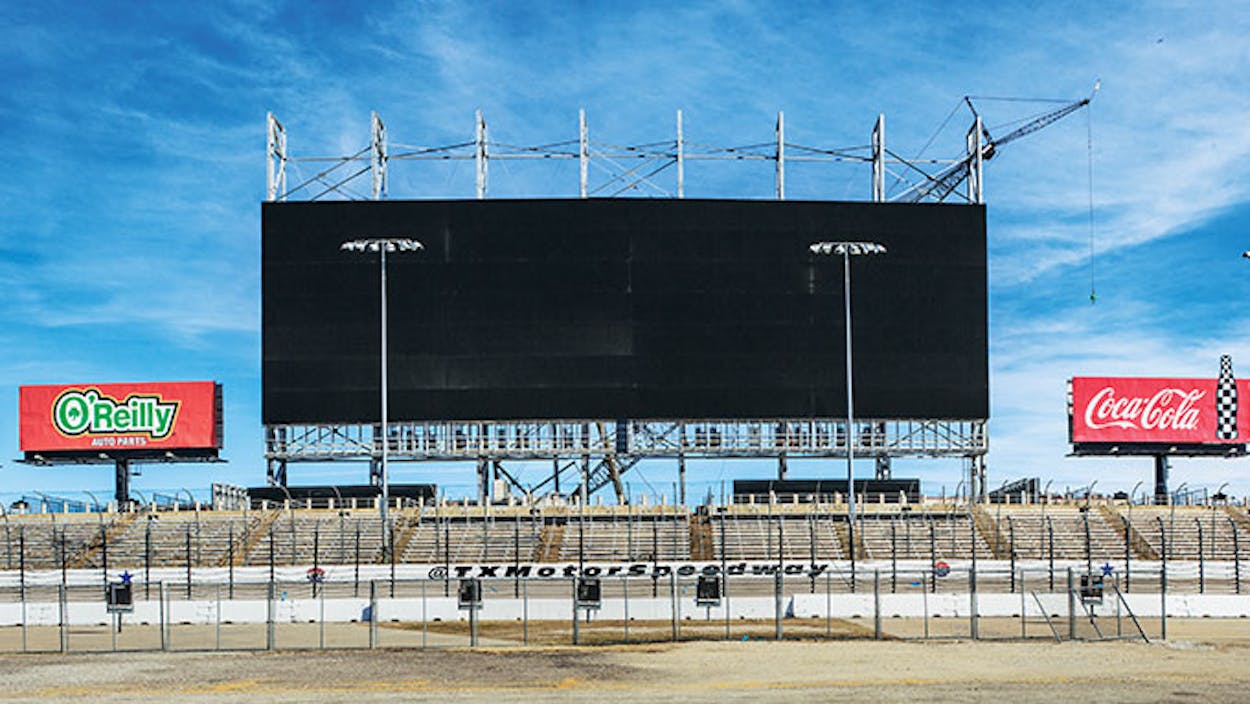It gets the couch potatoes off the couch,” says Eddie Gossage, the president of Texas Motor Speedway. He is referring to Big Hoss TV, the Fort Worth venue’s 20,633-square-foot HD video screen, which is set to be officially unveiled on April 6, at the annual NASCAR Sprint Cup Series race. If Gossage is aware of an irony here—that he’s trying to entice racing fans away from their televisions by luring them to his stadium to gape at a much bigger television—he isn’t letting on.
But then, Gossage doesn’t seem to let much bother him. A couple dozen journalists, mostly sportswriters, have gathered at the speedway on a blustery mid-February afternoon for a sneak preview of Big Hoss, but high winds and pesky OSHA regulations have forced workers off the job, leaving the last few pieces of the screen scattered on the ground, like so many hastily discarded Lego blocks. With construction having fallen behind schedule and tests yet to be completed, Big Hoss can’t actually be turned on for us. Nonetheless, Gossage intrepidly dons a hard hat and yellow construction vest and leads us to the “mega-board,” which is sited behind the backstretch of the racetrack.
When it debuts, Big Hoss will be the largest HD video screen in the world; it’s nearly twice the size of Jerry Jones’s 11,520-square-foot screen at AT&T Stadium, in Arlington, and 22 percent larger than the current record holder, the 16,000-square-foot video board at Charlotte Motor Speedway, in North Carolina. Its fourteen million LED bulbs are capable of displaying 4.8 million pixels and 281 trillion colors. “I didn’t even know there were that many colors in existence,” Gossage notes brightly.
On race days, the screen’s technical director will draw from nineteen camera feeds to create a viewing experience—think close-ups of nuts, bolts, and tire blowouts—that Gossage promises will be more detailed than anything racing fans at home will be able to see.
None of this came cheap, though Gossage won’t put a precise price tag on Big Hoss. “Tens of millions, but not hundreds of millions” is all he offers.
A reporter asks how they came up with the name. “Someone just said, ‘That thing is a big hoss,’ and it stuck,” Gossage says. “It kind of had that Western sound to it: ‘That’s a Big Hoss.’ ”
“You could also call it Jerry’s Envy,” someone suggests. Sportswriters are fond of inventing conflict where none likely exists.
“You have to give Jerry Jones credit for introducing the mega-board,” Gossage answers diplomatically.
Gossage may be reluctant to engage in one-upmanship because he knows the biggest screen in the world is going to be the biggest for only so long. In June, if all goes according to plan, Arena Corinthians, in São Paulo, Brazil, will debut its 36,500-square-foot screen just in time for the World Cup.
“It’s the biggest for now,” Gossage says. “If someone at another racetrack comes along and doesn’t make theirs bigger, then they are doing it wrong.”
- More About:
- Sports







